#California Agriculture news
Text
You can now tell Alexa to plant a tree
You can now tell Alexa to plant a tree
Good News Notes:
“Starting today, customers in the US can donate $1 to plant one tree by telling Alexa-enabled devices, “Alexa, grow a tree,” Amazon announced today. Customers will be able to keep track of how many trees they’ve planted in their Amazon Pay account.
Amazon also said that it’s donating $1 million to the environmental charity it’s partnering with on the initiative, called One Tree…

View On WordPress
#agriculture#Alexa-enabled devices#Amazon#Amazon Pay account#California#Centre County#combat climate change#donated#donating#donations#environmental charity#fight hunger#food source#foresters#fruit trees#good news#grow a tree#happy#help#improve local economies#India#joy#keep water clean#kindness#logging#need#One Tree Planted#orca whales#Pacific Northwest#Pennsylvania
2 notes
·
View notes
Text
Why do 80% of all Americans live east & only 20% west?
Studies of America's diverse geography reveal the complex dynamics that shape where Americans choose to reside. Many factors contribute to this lifestyle. "Rain Shadow" is the main factor in this. This web story has a detailed analysis. Click on the link to read more & swap the pages to move on.
#usa#usa news#usa people#united states of america#america today#rain shadow#california#oregon#washington dc#agriculture in USA#rocky mountains#pacific ocean#gulf of mexico
0 notes
Text
I first became fascinated with it a few years ago when I noticed it out an airplane window on a flight from Texas to Southern California. In an expanse of endless desert, suddenly, a vast body of water. When I got home, I immediately looked it up on a map. The Salton Sea.
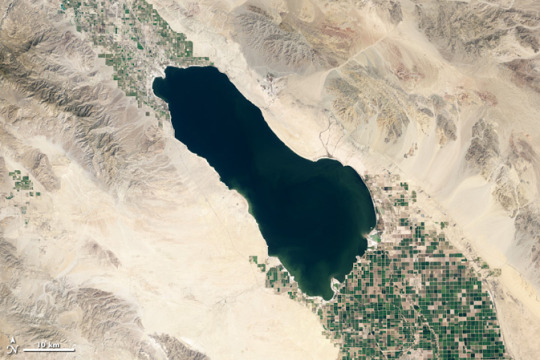
It’s the largest landlocked body of water in California. It sits right on top of the San Andreas Fault at over 200 feet below sea level. It is more than twice as salty as the Pacific Ocean. It is completely toxic. And I had never heard of it before then.
(photo essay under the cut)
In the early 1900s the Colorado River was diverted through a series of irrigation canals in order to provide water for the farmlands of Imperial Valley. One of the head-gates broke during a flood, and the desert basin filled with water for 2 years before it was fixed. The unexpected lake soon became a popular vacation destination; it was stocked with fish, and resorts and hotels popped up along its shores. It became known as a great place for sport fishing, waterskiing, and yacht parties. Big name celebrities visited. At one point, it had more annual visitors than Yosemite.
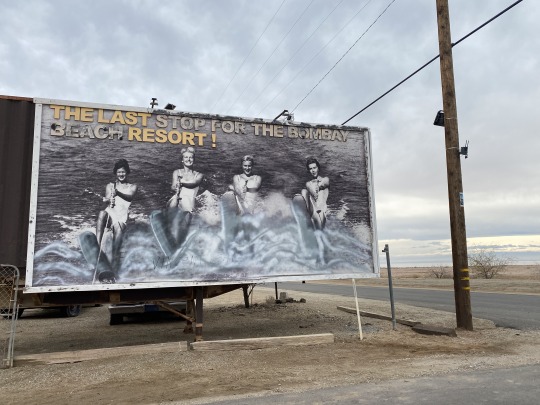
Salton Sea has no outlet, and is only filled via agricultural runoff. As the water evaporated in the hot desert sun, the lake became more and more saline. Chemicals began to build up from the run off causing toxic algae blooms, and mass die-offs of fish and birds started in the 80s. By the 90s, the beaches were littered with fish gills and bird bones and the resorts were abandoned. The lake began to dry up as irrigation run-off was diverted away. The exposed lake bed is also toxic, and the high desert winds kick up the dust, making the air poisonous.



Despite the unpleasant odor, the noxious air and the summer temperatures regularly reaching 120°, a renaissance of sorts began in the early 2010s. Artist and nomad colonies began to spring up around Salton Sea. Bombay Beach, once a popular resort destination, is now mostly a ghost town, but the folks who remain have turned the ruins on the shores into an outdoor art installation gallery where the found-art sculptures are cyclically destroyed by the elements and then replaced with new ones. Many of the houses and RVs in town are themselves art pieces.
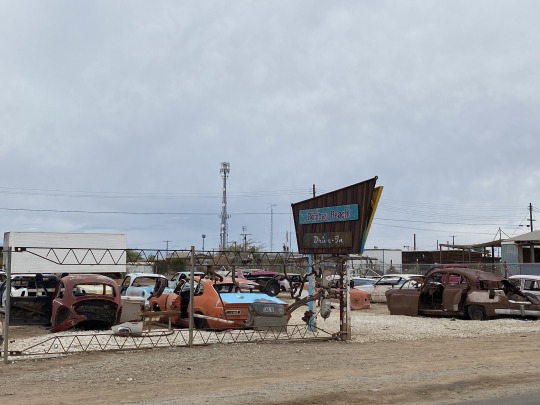



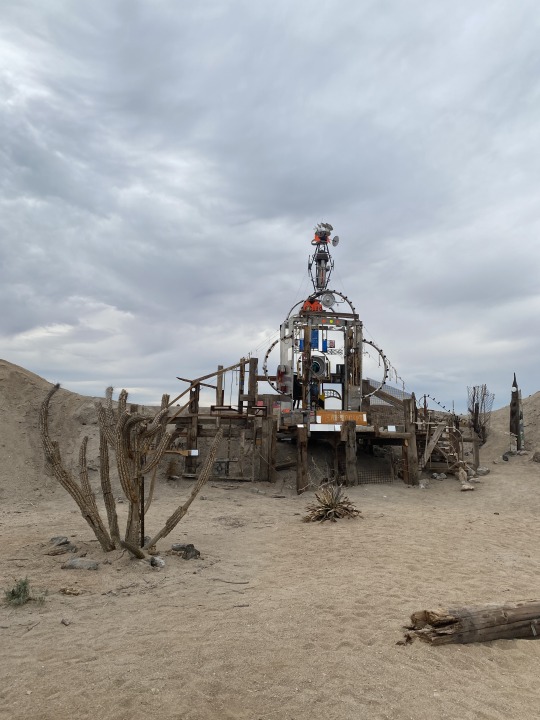

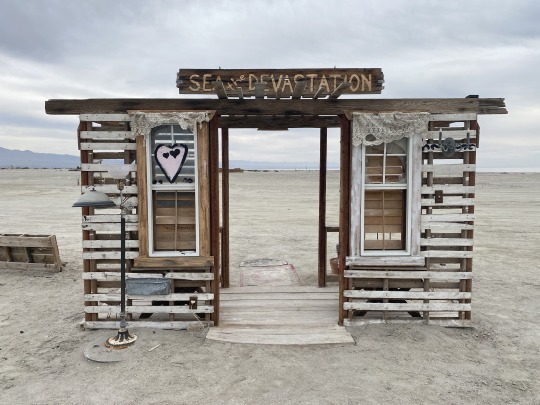
In nearby Slab City, a settlement of off-the-grid lifestylers, you can find even more folk art. Salvation Mountain is a manmade hill painted with bright colors and bible verses and maintained by a community of volunteers. East Jesus is a sculpture garden and art installation.
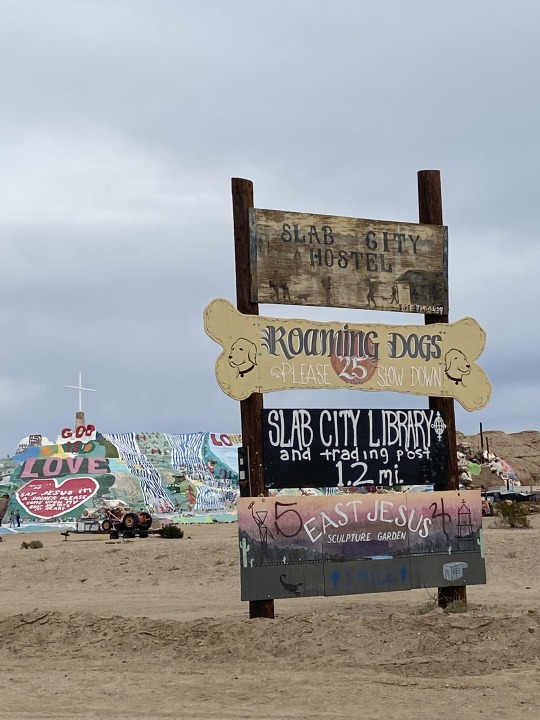




This past weekend my partner and I finally made the pilgrimage to the Sea. California has the benefit of being home to a huge array of biomes. In just a couple of hours you can travel from snowy mountain peaks to lush oases to endless sand dunes. Driving the hour or so south from Palm Springs towards Salton Sea is like driving towards the end of the world.

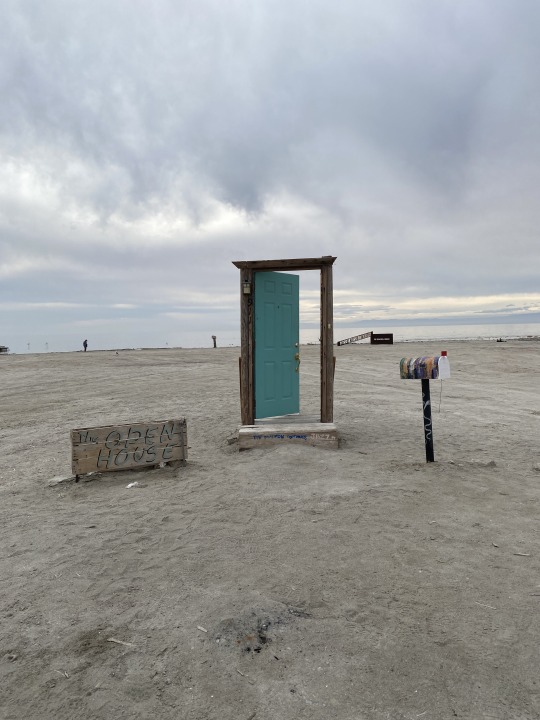

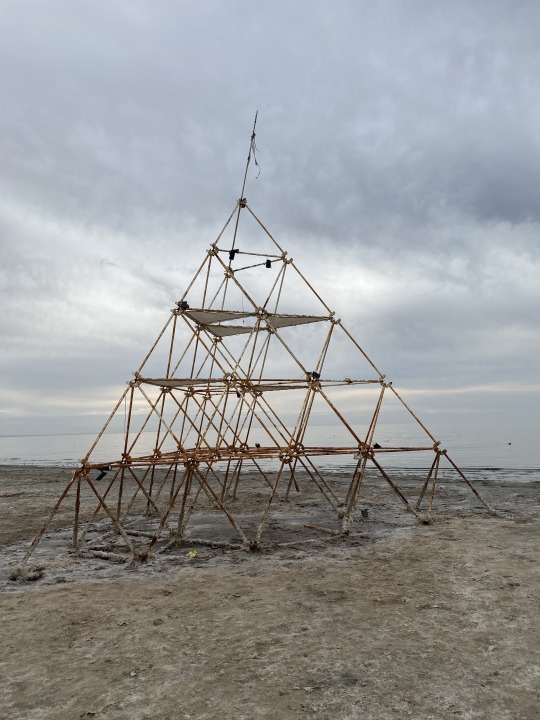

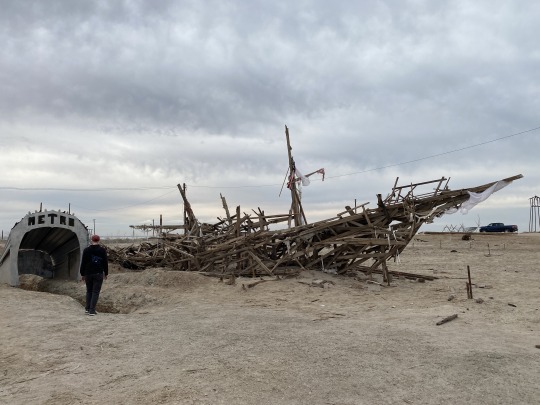
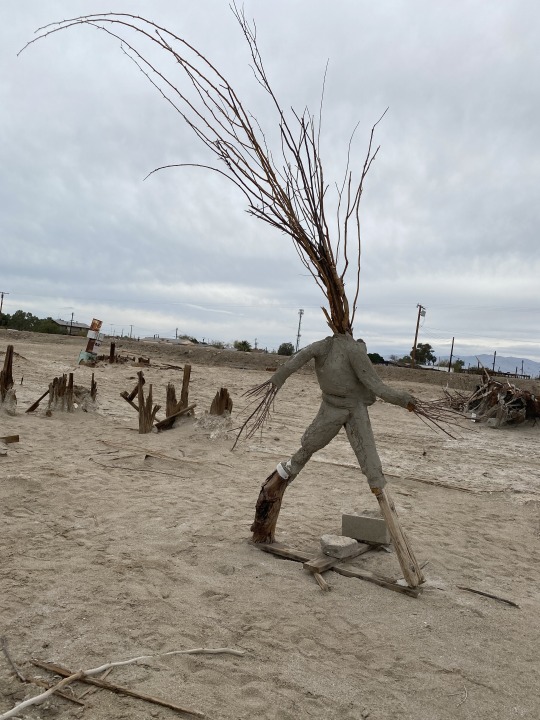
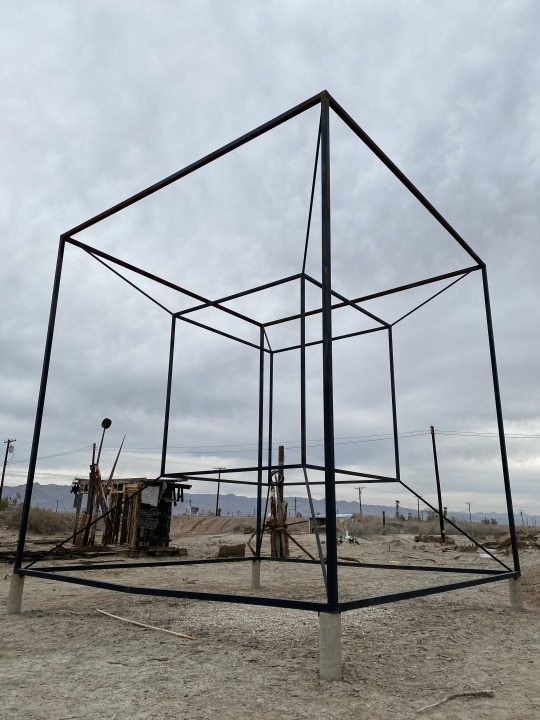
Bombay Beach especially enamored me. The beach is crusted with salt and millions of tiny shells and bones. It smells awful, like sewage and chemicals and low-tide and rotting fish. You drive out onto the beach and park anywhere amongst the sculptures and deteriorating resort ruins. The art feels raw in a way I haven’t experienced before. It reminds me of seeing paleolithic cave art. Humans made this, with no motivation other than to create something intriguing or beautiful or sad. Not much can live out here, but what you find fills me with a great adoration for humanity. Despite the asphyxiation of the natural world, the human spirit persists.



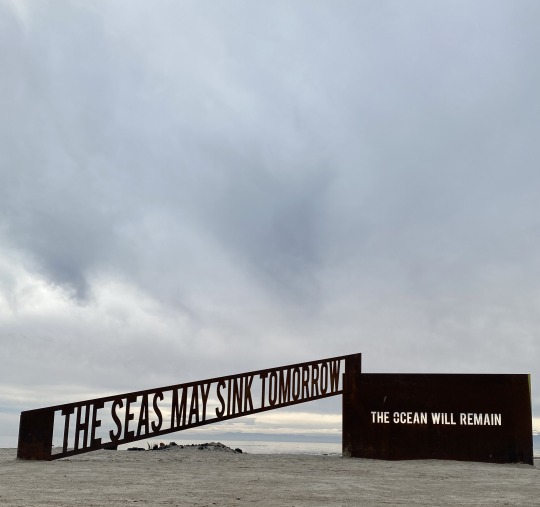
#im sure most people know about this place but i didnt so!!#i hated writing essays in school but now in my 30s i do it for fun apparently#photos are all mine except the first one#salton sea#bombay beach#slab city#salvation mountain
3K notes
·
View notes
Text
Netflix wants to chop down your family tree

Netflix has unveiled the details of its new anti-password-sharing policy, detailing a suite of complex gymnastics that customers will be expected to undergo if their living arrangements trigger Netflix’s automated enforcement mechanisms:
https://thestreamable.com/news/confirmed-netflix-unveils-first-details-of-new-anti-password-sharing-measures
If you’d like an essay-formatted version of this post to read or share, here’s a link to it on pluralistic.net, my surveillance-free, ad-free, tracker-free blog:
https://pluralistic.net/2023/02/02/nonbinary-families/#red-envelopes
Netflix says that its new policy allows members of the same “household” to share an account. This policy comes with an assumption: that there is a commonly understood, universal meaning of “household,” and that software can determine who is and is not a member of your household.
This is a very old corporate delusion in the world of technology. In the early 2000s, I spent years trying to bring some balance to an effort at DVB, whose digital television standards are used in most of the world (but not the USA) when they rolled out CPCM, a DRM system that was supposed to limit video-sharing to a single household.
Their term of art for this was the “authorized domain”: a software-defined family unit whose borders were privately negotiated by corporate executives from media companies, broadcasters, tech and consumer electronics companies in closed-door sessions all around the world, with no public minutes or proceedings.
https://onezero.medium.com/the-internet-heist-part-iii-8561f6d5a4dc
These guys (they were nearly all guys) were proud of how much “flexibility” they’d built into their definition of “household.” For example, if you owned a houseboat, or a luxury car with seatback displays, or a summer villa in another country, the Authorized Domain would be able to figure out how to get the video onto all those screens.
But what about other kinds of families? I suggested that one of our test cases should be a family based in Manila: where the dad travels to remote provinces to do agricultural labor; the daughter is a nanny in California; and the son is doing construction work in the UAE. This suggestion was roundly rejected as an “edge case.”
Of course, this isn’t an edge case. There are orders of magnitude more people whose family looks like this than there are people whose family owns a villa in another country. Owning a houseboat or a luxury car makes you an outlier. Having an itinerant agricultural breadwinner in your family does not.
But everyone who is in the room when a cartel draws up a standard definition of what constitutes a household is almost certainly drawn from a pool that is more likely to have a summer villa than a child doing domestic work or construction labor half a world away. These weirdos, so dissimilar from the global majority, get to define the boxes that computers will shove the rest of the world into. If your family doesn’t look like their family, that’s tough: “Computer says no.”
One day at a CPCM meeting, we got to talking about the problem of “content laundering” and how the way to prevent it would be to put limits on how often someone could leave a household and join another one. No one, they argued, would ever have to change households every week.
I put my hand up and said, “What about a child whose divorced parents share custody of her? She’s absolutely going to change households every week.” They thought about it for a moment, then the rep from a giant IT company that had recently been convicted of criminal antitrust violations said, “Oh, we can solve that: we’ll give her a toll-free number to call when she gets locked out of her account.”
That was the solution they went with. If you are a child coping with the dissolution of your parents’ marriage, you will have the obligation to call up a media company every month — or more often — and explain that Mummy and Daddy don’t love each other any more, but can I please have my TV back?
I never forgot that day. I even wrote a science fiction story about it called (what else?) “Authorized Domain”:
https://craphound.com/news/2011/10/31/authorised-domain/
I think everyone understood that this was an absurd “solution,” but they had already decided that they were going to complete the seemingly straightforward business of defining a category like “household” using software, and once that train left the station, nothing was going to stop it.
This is a recurring form of techno-hubris: the idea that baseline concepts like “family” have crisp definitions and that any exceptions are outliers that would never swallow the rule. It’s such a common misstep that there’s a whole enre* called “Falsehoods Programmers Believe About ______”:
https://github.com/kdeldycke/awesome-falsehood
In that list: names, time, currency, birthdays, timezones, email addresses, national borders, nations, biometrics, gender, language, alphabets, phone numbers, addresses, systems of measurement, and, of course, families. These categories are touchstones in our everyday life, and we think we know what they mean — but then we try to define them, and the list of exceptions spirals out into a hairy, fractal infinity.
Historically, these fuzzy categorical edges didn’t matter so much, because they were usually interpreted by humans using common sense. My grandfather was born “Avrom Doctorovitch” (or at least, that’s one way to transliterate his name, which was spelled in a different alphabet, but which was also transliterating his first name from yet another alphabet). When he came to Canada as a refugee, his surname was anglicized to “Doctorow.” Other cousins are “Doctorov,” “Doctoroff,” and “Doktorovitch.”
Naturally, his first name could have been “Abraham” or “Abe,” but his first employer (a fellow Eastern European emigre) decided that was too ethnic and in sincere effort to help him fit in, he called my grandfather “Bill.” When my grandfather attained citizenship, his papers read “Abraham William Doctorow.” He went by “Abe,” “Billy,” “Bill,” “William,” “Abraham” and “Avrom.”
Practically, it didn’t matter that variations on all of these appeared on various forms of ID, contracts, and paperwork. His reparations check from the German government had a different variation from the name on the papers he used to open his bank account, but the bank still let him deposit it.
All of my relatives from his generation have more than one name. Another grandfather of mine was born “Aleksander,” and called “Sasha” by friends, but had his name changed to “Seymour” when he got to Canada. His ID was also a mismatched grab-bag of variations on that theme.
None of this mattered to him, either. Airlines would sell him tickets and border guards would stamp his passport and rental agencies would let him drive away in cars despite the minor variations on all his ID.
But after 9/11, all that changed, for everyone who had blithely trundled along with semi-matching names across their official papers and database entries. Suddenly, it was “computer says no” everywhere you turned, unless everything matched perfectly. There was a global rush for legal name-changes after 9/11 — not because people changed their names, but because people needed to perform the bureaucratic ritual necessary to have the name they’d used all along be recognized in these new, brittle, ambiguity-incinerating machines.
For important categories, ambiguity is a feature, not a bug. The fact that you can write anything on an envelope (including a direction to deliver the letter to the granny flat over the garage, not the front door) means that we don’t have to define “address” — we can leave it usefully hairy around the edges.
Once the database schema is formalized, then “address” gets defined too — the number of lines it can have, the number of characters each line can have, the kinds of characters and even words (woe betide anyone who lives in Scunthorpe).
If you have a “real” address, a “real” name, a “real” date of birth, all of this might seem distant to you. These “edge” cases — seasonal agricultural workers, refugees with randomly assigned “English” names — are very far from your experience.
That’s true — for now (but not forever). The “Shitty Technology Adoption Curve” describes the process by which abusive technologies work their way up the privilege gradient. Every bad technological idea is first rolled out on poor people, refugees, prisoners, kids, mental patients and other people who can’t push back.
Their bodies are used to sand the rough edges and sharp corners off the technology, to normalize it so that it can climb up through the social ranks, imposed on people with more and more power and influence. 20 years ago, if you ate your dinner under an always-on #CCTV, it was because you were in a supermax prison. Today, it’s because you bought a premium home surveillance system from Google, Amazon or Apple.
https://pluralistic.net/2021/07/29/impunity-corrodes/#arise-ye-prisoners
The Netflix anti-sharing tools are designed for rich people. If you travel for business and stay in the kind of hotel where the TV has its own Netflix client that you can plug your username and password into, Netflix will give you a seven-day temporary code to use.
But for the most hardcore road-warriors, Netflix has thin gruel. Unless you connect to your home wifi network every 31 days and stream a show, Netflix will lock out your devices. Once blocked, you have to “contact Netflix” (laughs in Big Tech customer service).
Why is Netflix putting the screws to its customers? It’s part of the enshittification cycle, where platform companies first allocate surpluses to their customers, luring them in and using them as bait for business customers. Once they turn up, the companies reallocate surpluses to businesses, lavishing them with low commissions and lots of revenue opportunities. And once they’re locked in, the company starts to claw back the surpluses for itself.
https://pluralistic.net/2023/01/21/potemkin-ai/#hey-guys
Remember when Netflix was in the business of mailing red envelopes full of DVDs around the country? That was allocating surpluses to users. The movie companies hated this, viewed it as theft — a proposition that was at least as valid as Netflix’s complaints about password sharing, but every pirate wants to be an admiral, and when Netflix did it to the studios, that was “progress,” but when you do it to Netflix, that’s theft.
Then, once Netflix had users locked in and migrated to the web (and later, apps), it shifted surpluses to studios, paying fat licensing fees to stream their movies and connect them to a huge audience.
Finally, once the studios were locked in, Netflix started to harvest the surplus for its shareholders: raising prices, lowering streaming rates, knocking off other studios’ best performing shows with in-house clones, etc. Users’ surpluses are also on the menu: the password “sharing” that let you define a household according to your family’s own idiosyncratic contours is unilaterally abolished in a quest to punish feckless Gen Z kids for buying avocado toast instead of their own Netflix subscriptions.
Netflix was able to ignore the studios’ outraged howls when it built a business by nonconsenually distributing their products in red envelopes. But now that Netflix has come for your family, don’t even think about giving Netfix some of what it gave to the MPAA.
As a technical matter, it’s not really that hard to modify Netflix’s app so that every stream you pull seems to come from your house, no matter where you are. But doing so would require reverse-engineering Netflix’s app, and that would violate Section 1201 of the DMCA, the CFAA, and eleventy-seven other horrible laws. Netflix’s lawyers would nuke you until the rubble bounced.
When Netflix was getting started, it could freely interoperate with the DVDs that the studios had put on the market. It could repurpose those DVDs in ways that the studios strenuously objected to. In other words, Netfix used adversarial interoperability (AKA Competitive Compatibility or ComCom) to launch its business:
https://www.eff.org/deeplinks/2019/10/adversarial-interoperability
Today, Netflix is on the vanguard of the war to abolish adversarial interop. They helped lead the charge to pervert W3C web-standards, creating a DRM video standard called EME that made it a crime to build a full-featured browser without getting permission from media companies and restricting its functionality to their specifications:
https://blog.samuelmaddock.com/posts/the-end-of-indie-web-browsers/
When they used adversarial interoperability to build a multi-billion-dollar global company using the movie studios’ products in ways the studios hated, that was progress. When you define “family” in ways that makes Netflix less money, that’s felony contempt of business model.
[Image ID: A Victorian family tree template populated by tintypes of old-timey people. In the foreground stands a menacing, chainsaw-wielding figure, his face obscured by a hoodie. The blade of the chainsaw is poised to chop down the family tree. A Netflix 'N' logo has been superimposed over the man's face.]
#pluralistic#enshittification#shitty technology adoption curve#cpcm#interoperabiltiy#comcom#adversarial interoperability#interop#netflix#family#ambiguity#digitizatio#nym wars#authorized domain#dvb#dvds#password sharing
7K notes
·
View notes
Text
A historically and culturally significant lake in California's San Joaquin Valley that first disappeared in 1898 has returned after last year's atmospheric rivers flooded the region.
Tulare Lake, known as Pa'ashi — or "big water" — to the local Tachi Yokut Tribe, was "once the largest body of freshwater west of the Mississippi River," per Earth.com.
Vivian Underhill, who published a paper on Tulare Lake as a postdoctoral research fellow at Northeastern University, noted it was mostly sustained by snowmelt from the Sierra Nevada mountains and was 100 miles long and 30 miles wide at its peak.
The lake served as a key resource for Indigenous Peoples and wildlife and was once robust enough to allow steamships to transport agricultural goods throughout the state.
However, government officials persecuted and displaced the indigenous communities in the late 1800s to convert the area for farming through draining and irrigation.
"They really wanted to get [land] into private hands so that indigenous land claims — that were ongoing at that time — would be rendered moot by the time they went through the courts," Underhill told the Northeastern Global News. "It was a deeply settler colonial project."
While Pa'ashi periodically reappeared during the 1930s, '60s, and '80s, the barrage of atmospheric rivers California experienced in 2023 revived the lake despite the region receiving just 4 inches of rain annually. According to Underhill, Tulare Lake is now the same size as Lake Tahoe, which is 22 miles long and 12 miles wide.
Its resurgence has led to the return of humid breezes at least 10 degrees cooler than average and native species, including fish, amphibians, and birds. Lake Tulare was once a stopping point for migratory birds traveling a route known as the Pacific Flyway.
"Something that continues to amaze me is — [the birds] know how to find the lake again," Underhill told the Northeastern Global News. "It's like they're always looking for it."
The Tachi Yokuts have also returned to Pa'ashi's shores, once again practicing their ceremonies and planting tule reeds and native sage.
#submission#!!!#good news#lakes#Tulare Lake#Pa'ashi#big water#water#water is life#revitalization#anti colonialism#decolonization#nature#Tachi Yokut#indigenous peoples
407 notes
·
View notes
Text


The United States is about to embark on an experiment inspired by one of the New Deal’s most popular programs. On Wednesday, the Biden administration authorized the creation of the American Climate Corps through an executive order. The program would hire 20,000 young people in its first year, putting them to work installing wind and solar projects, making homes more energy-efficient, and restoring ecosystems like coastal wetlands to protect towns from flooding. ¹
Rep. Joe Neguse, a Colorado Democrat, said the program should pay “a living wage” while offering health care coverage and other benefits. ²
There are plans to link it with AmeriCorps, the national service program, and leverage several smaller climate corps initiatives that states have launched in California, Colorado, Maine, Michigan, and Washington. The White House also launched a new website where you can sign up to get updates about joining the program. ¹
The American Climate Corps is an interagency partnership between AmeriCorps, National Oceanic and Atmospheric Administration (NOAA) and the Departments of Labor, Interior, Agriculture, and Energy.³
Reviving the Civilian Conservation Corps is widely popular, with 84 percent of Americans supporting the idea in polling conducted by the Yale Program on Climate Change Communication last year. ¹
¹ Grist, Sep. 20ᵗʰ 2023 ² Boston, Sept. 21ˢᵗ. 2023 ³ AmeriCorps, Sept. 20ᵗʰ 2023
#climate change#news#biden#america#usa#global warming#environment#environmetalism#new deal#politics#work#jobs#economy#mine#articles
970 notes
·
View notes
Text
The Best News of Last Week
🦾 - High-Five for Bionic Hand
1. Houston-area school district announces free breakfast and lunch for students

Pasadena ISD students will be getting free breakfast and lunch for the 2023-24 school year, per an announcement on the district's social media pages.
The 2023-24 free lunch program is thanks to a Community Eligibility Provision grant the district applied for last year. The CEP, which is distributed by the Department of Agriculture, is specially geared toward providing free meals for low-income students.
2. Dolphin and her baby rescued after being trapped in pond for 2 years
youtube
A pair of dolphins that spent nearly two years stuck in a Louisiana pond system are back at sea thanks to the help of several agencies and volunteers.
According to the Audubon Nature Institute, wildlife observers believe the mother dolphin and her baby were pushed into the pond system near Grand Isle, Louisiana, during Hurricane Ida in late August 2021.
3. Studies show that putting solar panels over waterways could boost clean energy and conserve water. The first U.S. pilot project is getting underway in California.
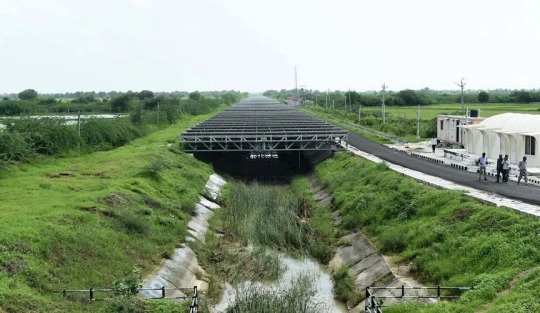
Some 8,000 miles of federally owned canals snake across the United States, channeling water to replenish crops, fuel hydropower plants and supply drinking water to rural communities. In the future, these narrow waterways could serve an additional role: as hubs of solar energy generation.
4. Gene therapy eyedrops restored a boy's sight. Similar treatments could help millions

Antonio was born with dystrophic epidermolysis bullosa, a rare genetic condition that causes blisters all over his body and in his eyes. But his skin improved when he joined a clinical trial to test the world’s first topical gene therapy.
The same therapy was applied to his eyes. Antonio, who’s been legally blind for much of his 14 years, can see again.
5. Scientists develop game-changing vaccine against Lyme disease ticks!
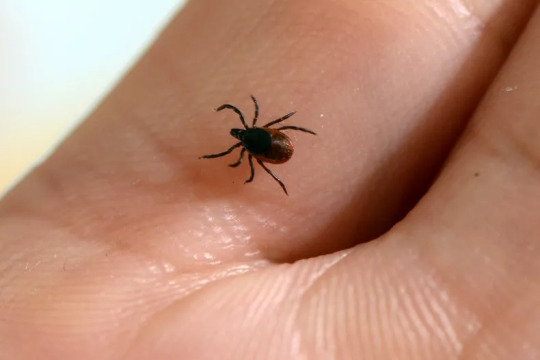
A major step in battling Lyme disease and other dangerous tick-borne viruses may have been taken as researchers announced they have developed a vaccine against the ticks themselves.
Rather than combatting the effects of the bacteria or microbe that causes Lyme disease, the vaccine targets the microbiota of the tick, according to a paper published in the journal Microbiota on Monday.
6. HIV Transmission Virtually Eliminated in Inner Sydney, Australia

Sydney may be the first city in the world to end AIDS as a public health threat by 2030. Inner Sydney has reduced new HIV acquisitions by 88%, meaning it may be the first locality in the world to reach the UN target to end AIDS as a public health threat by 2030
7. New bionic hand allows amputees to control each finger with unprecedented accuracy

In a world first, surgeons and engineers have developed a new bionic hand that allows users with arm amputations to effortlessly control each finger as though it was their own body.
Successful testing of the bionic hand has already been conducted on a patient who lost his arm above the elbow.
----
That's it for this week :)
This newsletter will always be free. If you liked this post you can support me with a small kofi donation:
Support this newsletter ❤️
Also don’t forget to reblog.
895 notes
·
View notes
Text

[ID: A bowl of avocado spread sculpted into a pattern, topped with olive oil and garnished with symmetrical lines of nigella seeds and piles of pomegranate seeds; a pile of pita bread is in the background. End ID]
متبل الأفوكادو / Mutabbal al-'afukadu (Palestinian avocado dip)
Avocados are not native to Palestine. Israeli settlers planted them in Gaza in the 1980s, before being evicted when Israel evacuated all its settlements in Gaza in 2005. The avocados, however, remained, and Gazans continued to cultivate them for their fall and winter harvest. Avocados have been folded into the repertoire of a "new" Palestinian cuisine, as Gazans and other Palestinians have found ways to interpret them.
Palestinians may add local ingredients to dishes traditionally featuring avocado (such as Palestinian guacamole, "جواكامولي فلسطيني" or "غواكامولي فلسطيني"), or use avocado in Palestinian dishes that typically use other vegetables (pickling them, for example, or adding them to salads alongside tomato and cucumber).
Another dish in this latter category is حمص الافوكادو (hummus al-'afukadu)—avocado hummus—in which avocado is smoothly blended with lemon juice, white tahina (طحينة البيضاء, tahina al-bayda'), salt, and olive oil. Yet another is متبّل الأفوكادو (mutabbal al-'afukadu). Mutabbal is a spiced version of بابا غنوج (baba ghannouj): "مُتَبَّل" means "spiced" or "seasoned," from "مُ" "mu-," a participlizing prefix, + "تَبَّلَ" "tabbala," "to have spices added to." Here, fresh avocado replaces the roasted eggplant usually used to make this smooth dip; it is mixed with green chili pepper, lemon juice, garlic, white tahina, sumac, and labna (لبنة) or yoghurt. Either of these dishes may be topped with sesame or nigella seeds, pomegranate seeds, fresh dill, or chopped nuts, and eaten with sliced and toasted flatbread.
Avocados' history in Palestine precedes their introduction to Gaza. They were originally planted in 1908 by a French order of monks, but these trees have not survived. It was after the Balfour Declaration of 1917 (in which Britain, having been promised colonial control of Palestine with the dissolution of the Ottoman Empire after World War 1, pledged to establish "a national home for the Jewish people" in Palestine) that avocado agriculture began to take root.
In the 1920s, 30s, and 40s, encouraged by Britain, Jewish Europeans began to immigrate to Palestine in greater numbers and establish agricultural settlements (leaving an estimated 29.4% of peasant farming families without land by 1929). Seeds and seedlings from several varieties of avocado were introduced from California by private companies, research stations, and governmental bodies (including Mikveh Israel, a school which provided settlers with agricultural training). In these years, prices were too high for Palestinian buyers, and quantities were too low for export.
It wasn't until after the beginning of the Nakba (the ethnic cleansing of Palestinians from "Jewish" areas following the UN partition of Palestine in 1947) that avocado plantings became significant. With Palestinians having been violently expelled from most of the area's arable land, settlers were free to plant avocados en masse for export, aided (until 1960) by long-term, low-interest loans from the Israeli government. The 400 acres planted within Israel's claimed borders in 1955 ballooned to 2,000 acres in 1965, then 9,000 by 1975, and over 17,000 by 1997. By 1986, Israel was producing enough avocados to want to renegotiate trade agreements with Europe in light of the increase.
Israeli companies also attained commercial success selling avocados planted on settlements within the West Bank. As of 2014, an estimated 4.5% of Israeli avocado exports were grown in the occupied Jordan Valley alone (though data about crops grown in illegal settlements is of course difficult to obtain). These crops were often tended by Palestinian workers, including children, in inhumane conditions and at starvation wages. Despite a European Union order to specify the origin of such produce as "territories occupied by Israel since 1967," it is often simply marked "Israel." Several grocery stores across Europe, including Carrefour, Lidl, Dunnes Stores, and Aldi, even falsified provenance information on avocados and other fruits in order to circumvent consumer boycotts of goods produced in Israel altogether—claiming, for example, that they were from Morocco or Cyprus.
Meanwhile, while expanding its own production of avocados, Israel was directing, limiting, and destabilizing Palestinian agriculture in an attempt to eliminate competition. In 1982, Israel prohibited the planting of fruit trees without first obtaining permission from military authorities; in practice, this resulted in Palestinians (in Gaza and the West Bank) being entirely barred from planting new mango and avocado trees, even to replace old, unproductive ones.
Conditions worsened in the years following the second intifada. Between September of 2000 and September of 2003, Israeli military forces destroyed wells, pumps, and an estimated 85% of the agricultural land in al-Sayafa, northern Gaza, where farmers had been using irrigation systems and greenhouses to grow fruits including citrus, apricots, and avocados. They barred almost all travel into and out of al-Sayafa: blocking off all roads that lead to the area, building barricades topped with barbed wire, preventing entry within 150 meters of the barricade under threat of gunfire, and opening crossings only at limited times of day and only for specific people, if at all.
A July 2001 prohibition on Palestinian vehicles within al-Sayafa further slashed agricultural production, forcing farmers to rely on donkeys and hand carts to tend their fields and to transport produce across the crossing. If the crossing happened to be closed, or the carts could not transport all the produce in time, fruits and vegetables would sit waiting in the sun until they rotted and could not be sold. The 2007 blockade worsened Gaza's economy still further, strictly limiting imports and prohibiting exports entirely (though later on, there would be exceptions made for small quantities of specific crops).
In the following years, Israel allowed imports of food items into Gaza not exceeding the bare minimum for basic sustenance, based on an estimation of the caloric needs of its inhabitants. Permitted (apples, bananas, persimmons, flour) and banned items for import (avocados, dates, grapes) were ostensibly based on "necessary" versus "luxury" foods, but were in fact directed according to where Israeli farmers could expect the most profit.
Though most of the imports admitted into Gaza continued to come from Israel, Gazan farmers kept pursuing self-sufficiency. In 2011, farmers working on a Hamas-government-led project in the former settlements produced avocados, mangoes, and most of the grapes, onions, and melons that Gazans ate; by 2015, though still forbidden from exporting excess, they were self-sufficient in the production of crops including onions, watermelon, cantaloupe, grapes, almonds, olives, and apples.
Support Palestinian resistance by calling Elbit System’s (Israel’s primary weapons manufacturer) landlord, donating to Palestine Action’s bail fund, and donating to the Bay Area Anti-Repression Committee bail fund.
Ingredients:
2 medium avocados (300g total)
1/4 cup white tahina
2 Tbsp labna (لبنة), or yoghurt (laban, لبن رايب)
1 green chili pepper
2 cloves garlic
2 Tbsp good olive oil
Juice of 1/2 lemon (1 1/2 Tbsp)
1 tsp table salt, or to taste
Pomegranate seeds, slivered almonds, pine nuts, chopped dill, nigella seeds, sesame seeds, sumac, and/or olive oil, to serve
Khubiz al-kmaj (pita bread), to serve
Instructions:
1. In a mortar and pestle, crush garlic, pepper, and a bit of salt into a fine paste.
2. Add avocados and mash to desired texture. Stir in tahina, labna, olive oil, lemon juice, and additional salt.
You can also combine all ingredients in a blender or food processor.
3. Top with a generous drizzle of olive oil. Add toppings, as desired.
4. Cut pita into small rectangles or triangles and separate one half from the other (along where the pocket is). Toast in the oven, or in a large, dry skillet, stirring occasionally, until golden brown. Serve dip alongside toasted pita chips.

455 notes
·
View notes
Text
Vault-Tec Vaults; Game Origin & Location
Hi I'm going to back to my "Fallout Blog" roots. Here is a summary of all of the vaults and experiments (starting with a timeline) because I'm insane ^_^ I had to add a weird break bc I literally hit the tumblr character limit, but I used it to section off the major spoilers for the TV series :)
Timeline
The Great War: October 23rd, 2077
Fallout Bible: Compendium of added lore by the creators.
Fallout 76: 2102
Fallout 1: 2161
Fallout Tactics: 2197
Fallout: Brotherhood of Steel: 2208
Fallout 2: 2241
Fallout 3: 2277
Fallout: New Vegas: 2281
Fallout 4: 2287
Fallout TV Series: 2296
Corporate Vault - Fallout: Brotherhood of Steel - Texas
A control group vault meant for Vault-Tec employees to continue research, primarily on FEV (Forced Evolutionary Virus) during the war.
Vault 0 - Fallout Tactics - Colorado
A control group vault with geniuses kept in cryogenic stasis, with their minds interlinked into an entity called The Calculator.
Vault 3 - Fallout: New Vegas - Nevada
A control vault. Residents ended up opening the vault doors when the lower levels flooded. Eventually the vault was overrun by Fiends.
Vault 4 - Fallout TV series - California
A test vault that was filled with residents prior to the bombs dropping. Experimentation on human subjects led to most of the original residents being killed in a revolt. In 2296 the vault is still thriving, while kidnapping surface survivors and continuing to experiment on them. The vault offered refuge for many inhabitants of Shady Sands.
Vault 8 (Vault City) - Fallout 2 - Nevada
A control group vault that remained closed until 2241. Instead of receiving two G.E.C.K. (Garden of Eden Creation Kit) devices, Vault 8 received just one and a replacement water chip that was supposed to go to Vault 13.
Vault 11 - Fallout: New Vegas - Nevada
Every year the residents were told to sacrifice a fellow resident, with the threat of everyone's death if they did not. In reality, the system would praise them for NOT sacrificing an individual and the vault door would be unlocked. This message finally played after only five residents remained.
Vault 12 - Fallout 1 - California
A seemingly normal, safe vault with an ulterior motive to study the effects of radiation on the inhabitants. The door never fully sealed, and in 2083 the ghoul residents left to found Necropolis.
Vault 13 - Fallout 1 & Fallout 2- California
Your home vault as the Vault Dweller. A rather normal vault, however due to a shipping mishap Vault 13 received an additional G.E.C.K. device (that was supposed to go to Vault 8) instead of a replacement water chip. Thus, leaving the Vault Dweller to leave the vault in search for a replacement when their only water chip breaks.
Vault 15 - Fallout 1 & Fallout 2 - California
A vault that experimented with incredibly diverse ideologies and backgrounds. The vault became severely overpopulated in 2097 and the dwellers decided to open the door. Shady Sands was created using Vault 15's G.E.C.K. and the local raider gangs all have origins from this vault.
Vault 17 - Fallout: New Vegas - Mention Only
Inhabitants were kidnapped and transformed into Super Mutants. Lily originates from this vault.
Vault 19 - Fallout: New Vegas - Somewhere in CA/NV/AZ/UT
Paranoia was induced by noises, lights, and segregation. The vault was divided into two sections, Red and Blue, with a separate overseer for each sector.
Vault 21 - Fallout: New Vegas - Nevada
An almost normal vault, with the exception of a culture and society built around gambling. All major decisions were made through gambling, with the decision to open the doors and become part of New Vegas being "won" in a game of Blackjack.
Vault 22 - Fallout: New Vegas - Somewhere in CA/NV/AZ/UT
A vault dedicated to studying agriculture. A fungus designed to kill pests on plants became capable of infected human hosts. Vault 22 is curiously green on the outside by the time The Courier arrives at the location.
Vault 24 - Fallout: New Vegas - Mention Only
Remnants of a Vault 24 jumpsuit are found in the FNV game files.
Vault 27 - Fallout Bible - Mention Only
A vault designed to be deliberately overcrowded with not enough means to sustain the inhabitants.
Vault 29 - Fallout 76 - Mention Only
Only children younger than 15 were allowed in this vault, with their parents being sent to other vaults. Harold is believed to originate from this vault.
//TV SHOW SPOILERS//
Vault 31 - Fallout TV Series - California
Part of 3 interconnected vaults, serving as cryogenic home for the managers and higher ups of Vault-Tec.
Vault 32 - Fallout TV Series - California
Part of 3 interconnected vaults, serving as a healthy breeding pool for Vault 31 and 33. Somewhere around 2294, Vault 32 failed and the residents resorted to murder, cannibalism, or suicide.
Vault 33 - Fallout TV Series - California
Lucy MacLean's home vault. Part of 3 interconnected vaults, serving as a healthy breeding pool for Vault 31 and 32.
//END OF TV SHOW SPOILERS//
Vault 36 - Fallout Bible - Mention Only
The only food in this vault consisted of thin, watery gruel.
Vault 34 - Fallout: New Vegas - Somewhere in CA/NV/AZ/UT
The vault was purposefully overstocked with guns with the overseer being able to give/deny access to residents. This inevitably led to it's downfall, and those who revolted and raided the armory relocated above as The Boomers in 2231.
Vault 42 - Fallout Bible - Mention Only
No lightbulbs over 40W were provided.
Vault 43 - Fallout Bible - Mention Only
A vault containing 20 men, 10 women, and one panther.
Vault 51 - Fallout 76 - West Virginia
A vault with a supercomputer as the overseer. Interference from the computer led to most of the residents being murdered by other residents.
Vault 53 - Fallout Bible - Mention Only
Most equipment was designed to break down every few months in order to stress out inhabitants.
Vault 55 - Fallout Bible - Mention Only
No entertainment tapes were provided.
Vault 56 - Fallout Bible - Mention Only
The only entertainment tapes provided were of one terrible comedian.
Vault 63 - Fallout 76 - West Virginia
The inside of the vault remains sealed, with the outside door being all that is accessible to the player character. Other parts of the vault are revealed through cut content.
Vault 65 - Fallout 76 - Mention Only
Remnants of the vault remain in Fallout 76 cut content.
Vault 68 - Fallout Bible - Mention Only
The vault contained 999 men and 1 woman.
Vault 69 - Fallout Bible - Mention Only
The vault contained 999 women and 1 man.
Vault 75 - Fallout 4 - Massachusetts
A secret experimenting in refining human genetics through selective breeding, genetic modification, and hormonal treatments. The vault's concept was made by Stanislaus Braun.
Vault 76 - Fallout 76 - West Virginia
The home vault of the player character in 76. It was a control vault, set to open after 25 years. This is when the player character leaves the vault.
Vault 77 - Fallout 3 - Mention Only
Mentioned by slavers in Paradise Falls, this vault was rumored to only contain one man and a box of puppets.
Vault 79 - Fallout 76 - West Virginia
A vault dedicated to hoarding the country's gold reserves.
Vault 81 - Fallout 4 - Massachusetts
Designed to develop a cure for every possible sickness or ailment. Residents were unknowingly sprayed with diseases by nozzles hidden in their rooms. The first vault overseer had thought this to be cruel, cut off the scientists from the rest of the vault and cut the nozzles from spraying residents before the experiments could begin.
Vault 87 - Fallout 3 - Somewhere in VA/PA/MD
The original vault experiment for 87 was scrapped, and it became a research center for FEV, leaving the vault wildly radioactive and inhabited only by super mutants by the time you access it as the Lone Wanderer.
Vault 88 - Fallout 4 - Massachusetts
An unfinished vault inhabited by ghouls.
Vault 92 - Fallout 3 - Somewhere in VA/PA/MD
The best musicians were sent to this vault to "preserve musical talent", but truthfully residents were subjected to subliminal messages mixed into white noise. Eventually some of the musicians went into random, murderous, psychotic rages that led to the end of the experiment.
Vault 94 - Fallout 76 - West Virginia
A vault with non-violent faith-centric inhabitants. The vault opened one year later to search for survivors. The vault became overrun by wastelanders and raiders that destroyed their G.E.C.K. and their nuclear reactor. The vault was swarmed with radiation and is now overrun by mirelurks.
Vault 95 - Fallout 4 - Massachusetts
A vault designed to get people clean and sober. After a successful 5 years, a Vault-Tec agent brought out a hidden stash of drugs for other residents to find.
Vault 96 - Fallout 76 - West Virginia
A vault with a focus on agriculture, animals, genetics, and mutations. The original residents were killed in a failed escape attempt, and the vault was then used by West-Tek scientist Edgar Blackburn to continue research on FEV.
Vault 100 - Fallout 3 - Mention Only
Remnants of Vault 100 can be found in game files and cut content.
Vault 101 - Fallout 3 - Somewhere in VA/PA/MD
The home vault for the Lone Wanderer. This vault was meant to never open and Vault 101 did not receive a G.E.C.K. However, the overseer of the vault pretty quickly broke this rule and occasional survey teams were sent to the surface. Several residents of Megaton are the result of these survey teams. Daddy James found the vault after the birth of the Lone Wanderer and negotiated his doctoral services in exchange for shelter.
Vault 106 - Fallout 3 - Somewhere in VA/PA/MD
Psychoactive drugs slowly released into the air of Vault 106, causing the vault to be filled with psychotic survivors by the time the Lone Wanderer visits.
Vault 108 - Fallout 3 - Somewhere in VA/PA/MD
A slew of experiments occurred in this vault. The elected overseer was dying of cancer, the primary power supply of the vault was scheduled to fail after 20 years, the backup power supply would not be enough to power ALL of the vault, the vault was given three times the normal amount of weapons, and the vault was not given entertainment. With a majority of scientists, one of the inner experiments involved repeatedly cloning the same man... Gary.
Vault 111 - Fallout 4 - Massachusetts
Your home vault as the Sole Survivor. All residents were meant to unknowingly stay in cryostasis, with scientists overlooking them. However, conflicts arose among those unfrozen, leading to the vault door eventually being opened.
Vault 112 - Fallout 3 - Somewhere in VA/PA/MD
Residents lived in a virtual reality simulation to create their "perfect life" with their overseer, Stanislaus Braun, a scientist who proceeded to use the residents as playthings. Braun continuously murdered residents, then wiped their memories and reset the simulation.
Vault 114 - Fallout 4 - Massachusetts
An unfinished vault meant for only the wealthy. Vault-Tec exaggerated the luxury of the vault, gave residents very small rooms, communal bathing and dining areas, and a homeless drug-addicted overseer named Soup Can Harry.
Vault 118 - Fallout 4 - Maine
An Unfinished Vault meant to house both a handful of ultra-rich and hundreds of working class individuals to observe how they would interact within the same space.
Vault 120 - Fallout 4 & Fallout 76 - Mention Only
The vault itself was meant to mimic the underwater atmosphere of Bioshock. The game was cut from Fallout 4, but remnants can be found in Fallout 76 game files.
#fallout#fallout 1#fallout 2#fallout 3#fallout 4#fallout new vegas#fnv#fallout 76#fallout the series#fallout tv series#fallout tv#fallout amazon#fallout prime#bethesda#fallout lore#lore#brotherhood of steel#shady sands#sole survivor#vault dweller#lone wanderer#fo3#fallout nv#courier#vault 76#vault tec#fallout ghoul#fallout on prime
203 notes
·
View notes
Text
Determined to use her skills to fight inequality, South African computer scientist Raesetje Sefala set to work to build algorithms flagging poverty hotspots - developing datasets she hopes will help target aid, new housing, or clinics.
From crop analysis to medical diagnostics, artificial intelligence (AI) is already used in essential tasks worldwide, but Sefala and a growing number of fellow African developers are pioneering it to tackle their continent's particular challenges.
Local knowledge is vital for designing AI-driven solutions that work, Sefala said.
"If you don't have people with diverse experiences doing the research, it's easy to interpret the data in ways that will marginalise others," the 26-year old said from her home in Johannesburg.
Africa is the world's youngest and fastest-growing continent, and tech experts say young, home-grown AI developers have a vital role to play in designing applications to address local problems.
"For Africa to get out of poverty, it will take innovation and this can be revolutionary, because it's Africans doing things for Africa on their own," said Cina Lawson, Togo's minister of digital economy and transformation.
"We need to use cutting-edge solutions to our problems, because you don't solve problems in 2022 using methods of 20 years ago," Lawson told the Thomson Reuters Foundation in a video interview from the West African country.
Digital rights groups warn about AI's use in surveillance and the risk of discrimination, but Sefala said it can also be used to "serve the people behind the data points". ...
'Delivering Health'
As COVID-19 spread around the world in early 2020, government officials in Togo realized urgent action was needed to support informal workers who account for about 80% of the country's workforce, Lawson said.
"If you decide that everybody stays home, it means that this particular person isn't going to eat that day, it's as simple as that," she said.
In 10 days, the government built a mobile payment platform - called Novissi - to distribute cash to the vulnerable.
The government paired up with Innovations for Poverty Action (IPA) think tank and the University of California, Berkeley, to build a poverty map of Togo using satellite imagery.
Using algorithms with the support of GiveDirectly, a nonprofit that uses AI to distribute cash transfers, the recipients earning less than $1.25 per day and living in the poorest districts were identified for a direct cash transfer.
"We texted them saying if you need financial help, please register," Lawson said, adding that beneficiaries' consent and data privacy had been prioritized.
The entire program reached 920,000 beneficiaries in need.
"Machine learning has the advantage of reaching so many people in a very short time and delivering help when people need it most," said Caroline Teti, a Kenya-based GiveDirectly director.
'Zero Representation'
Aiming to boost discussion about AI in Africa, computer scientists Benjamin Rosman and Ulrich Paquet co-founded the Deep Learning Indaba - a week-long gathering that started in South Africa - together with other colleagues in 2017.
"You used to get to the top AI conferences and there was zero representation from Africa, both in terms of papers and people, so we're all about finding cost effective ways to build a community," Paquet said in a video call.
In 2019, 27 smaller Indabas - called IndabaX - were rolled out across the continent, with some events hosting as many as 300 participants.
One of these offshoots was IndabaX Uganda, where founder Bruno Ssekiwere said participants shared information on using AI for social issues such as improving agriculture and treating malaria.
Another outcome from the South African Indaba was Masakhane - an organization that uses open-source, machine learning to translate African languages not typically found in online programs such as Google Translate.
On their site, the founders speak about the South African philosophy of "Ubuntu" - a term generally meaning "humanity" - as part of their organization's values.
"This philosophy calls for collaboration and participation and community," reads their site, a philosophy that Ssekiwere, Paquet, and Rosman said has now become the driving value for AI research in Africa.
Inclusion
Now that Sefala has built a dataset of South Africa's suburbs and townships, she plans to collaborate with domain experts and communities to refine it, deepen inequality research and improve the algorithms.
"Making datasets easily available opens the door for new mechanisms and techniques for policy-making around desegregation, housing, and access to economic opportunity," she said.
African AI leaders say building more complete datasets will also help tackle biases baked into algorithms.
"Imagine rolling out Novissi in Benin, Burkina Faso, Ghana, Ivory Coast ... then the algorithm will be trained with understanding poverty in West Africa," Lawson said.
"If there are ever ways to fight bias in tech, it's by increasing diverse datasets ... we need to contribute more," she said.
But contributing more will require increased funding for African projects and wider access to computer science education and technology in general, Sefala said.
Despite such obstacles, Lawson said "technology will be Africa's savior".
"Let's use what is cutting edge and apply it straight away or as a continent we will never get out of poverty," she said. "It's really as simple as that."
-via Good Good Good, February 16, 2022
#older news but still relevant and ongoing#africa#south africa#togo#uganda#covid#ai#artificial intelligence#pro ai#at least in some specific cases lol#the thing is that AI has TREMENDOUS potential to help humanity#particularly in medical tech and climate modeling#which is already starting to be realized#but companies keep pouring a ton of time and money into stealing from artists and shit instead#inequality#technology#good news#hope
199 notes
·
View notes
Text
Making Better State Insects
So at some point I stumbled across a list of State Insects. Honestly I wasn't even aware states had "state insects", but as I looked down the list my disappointment grew. A vast majority of states had selected the European honeybee (which is not even native) as their state insect, with monarch butterflies and ladybugs being the two runner ups. I thought this was a damn shame because there's so many interesting insects in the US, so I'm making a better official new list of state insects.
For this list my criteria are:
Insect must be native to the state
No repeats
Insect must be easily observable to the naked eye
I also had general guidelines of picking insects that were relatively common (based on inaturalist heat maps of observation) and picking insects that were cool or interesting. Some of these insects I picked because I thought they were important parts of the areas culture and experience (lovebugs, toebiters, and periodical cicadas) and some insects I picked just to raise awareness that they exist in the US.
I also don't think I gave anyone huge L's, no mosquitoes, louses, cockroaches, ect, because my goal of this list is to get people interested in their native insects and I want it to be fun to find and observe your state insect.
Also some states get gold stars for picking state insects that already meet these criteria and are cool so they get to keep theirs. Some states also have "state butterflies" or "state agricultural insect" which for this list I'm ignoring, you can keep those I'm just focused on state insects. Slight disclaimer also, I've only ever lived in California, Nevada, Oregon, Washington, and South Carolina, and all these states are keeping their original state insect. So all the insects I'm choosing are for states I haven't lived in. Also I'm not including photos in this post just for my own sanity.
List under the cut!
Alabama
Old: Monarch Butterfly
New: Giant Leaf-footed Bug (Acanthocephala declivis)
Leaf-footed bugs are cute, they're big, they're stanced up, the males have big back legs, you've probably seen them. Being true bugs they have piercing mouthparts and suck plant juices.
Alaska
Four-spot Skimmer (Libellula quadrimaculata)
Alaska gets to keep their old state insect, it's a cool dragonfly and apparently was partially chosen to honor bush pilots who fly to deliver supplies in the Alaskan wilderness, so really cool!
Arizona
Two-tailed swallowtail butterfly (Papilio multicaudata)
Arizona also gets to keep their state insect. Kind of a shame because Arizona has a lot of cool species, but it did meet my requirements and they get points for choosing a different kind of butterfly.
Arkansas
Old: European honeybee
New: North American Wheel Bug (Arilus cristatus)
One of the largest assassin bugs in the US, these guys are appreciated by gardeners for their environmentally friendly pest control. They also look badass.
California
California Dogface Butterfly (Zerene eurydice)
Endemic to California and on a stamp! Again, kind of a shame because there's a lot of cool insects in California, but I respect this choice, especially since California was the first state to designate a state insect (1929).
Colorado
Colorado Hairstreak Butterfly (Hypaurotis crysalus)
Same deal as California, the state's name is in the common name, unique butterfly found in the four corners region. Just get a stamp or something soon!
Connecticut
Old: European Praying Mantis
New: Cecropia Moth (Hyalophora cecropia)
You picked a state insect no one else had but went with a nonnative mantis? Here's an insect that'll make you stand out and it's a native species. Lesser known than some of the other giant silk moths, the Cecropia moth is the largest native moth and has some truly stunning colors.
Delaware
Old: Convergent Ladybeetle
New: Periodical Cicada (Magicicada septendecim)
Cicada's had to be somewhere on this list and Delaware was one of the main hotspots for brood X, one of the largest broods of the multiple staggered brood cycles. Hey, they have a lot of history in America. Accounts go back as early as 1733, with Thomas Jefferson and Benjamin Franklin making a note of them.
District of Columbia
Old: None
New: Monarch Butterfly (Danaus plexippus)
The Entomological Society of America is trying to get the Monarch Butterfly added as our national insect, so I think that's reason enough to let DOC claim it.
Florida
Zebra Butterfly (Heliconius charithonia)
Florida gets to keep their state butterfly, but the populations that have existed in Florida are in steep decline. Ideally I would want being the official state insect to come with some protections, hopefully people can get invested in reintroducing them.
Georgia
Old: European Honeybee
New: Horned Passalus Beetle (Odontotaenius disjunctus)
Also called bess beetles or patent-leather beetles, these cute guys are important for forest systems because they eat decaying wood, helping to break down felled trees. They're cute beetles that squeak when disturbed.
Hawaii
Kamehameha Butterfly (Vanessa tameamea)
An endemic Hawaiian butterfly named after a ruling dynasty of Hawaii. Their population is under threat, as with a lot of native Hawaiian species, so I think this is a good state insect to build protections and activism around.
Idaho
Old: Monarch Butterfly
New: Ice Crawler (Grylloblatta sp. "Polaris Peak")
Look Idaho, I have to admit that even though I've traveled extensively through WA, OR, CA, and NV I've never stepped foot in Idaho and I don't intend to. Your state exists in a weird liminal zone, not really the pacific northwest but not really whatever Montana is either. Your state isn't even all in one time zone. So look, I really wanted ice crawlers to be on this list, but they're exclusively found on mountains in the pacific northwest and Sierra Nevadas. Normally I would've given them to Washington or Oregon, but those states already have state insects that work for them. So your state gets ice crawlers, and they do exist in Idaho in the panhandle. It's not an L, ice crawlers are amazing extremophiles that crawl over snow in high elevation mountain peaks. They exist in their own unique order and theres only one genus in the US, with different species being region locked, sometimes onto specific mountains. Their thermoregulation is so delicate, the warmth of someones hand holding them causes them to over heat and die. They're cool, unique, and weird, and let's face it so is your state. At least I didn't take a cop out by picking the potato bug.
Illinois
Old: Monarch Butterfly
New: Red-banded Leafhopper (Graphocephala coccinea)
Leafhopper done Chicago style.
Indiana
Old: Say's Firefly
New: Common True Katydid (Pterophylla camellifolia)
I wanted to give you Say's Firefly. I really did. But when I looked on Inaturalist not A SINGLE OBSERVATION was listed for the species in Indiana. I'm even going to post pictures.
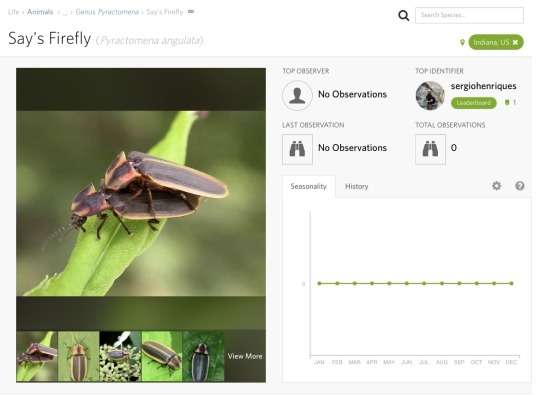
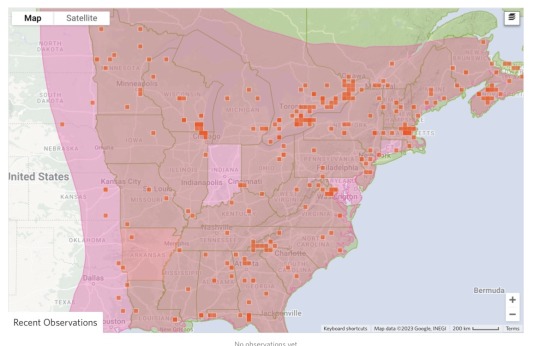
So even though this is extremely funny I'm giving your state the Common True Katydid instead. Large, loud, and easy to spot, these guys can frequently be heard chirping in trees. Not only do different populations have different rates of chirp, but the rate of chirp is also so predictably dependent on temperature that you could make an equation to tell the temperature based on chirp rate.
Iowa
Old: None
New: Westfall's Snaketail (Ophiogomphus westfalli)
Really cool clubtail dragonfly that's almost exclusively found in Iowa, Missouri, and Arkansas.
Kansas
Old: European Honeybee
New: Rainbow Scarab (Phanaeus vindex)
A kind of true dung beetle, they play an important role in removing waste. And although they don't roll waste like the stereotypical dung beetles, they are extremely pretty.
Kentucky
Viceroy Butterfly (Limenitis archippus)
This is fine.
Louisiana
Old: European Honeybee
New: Lovebug (Plecia nearartica)
Look, one of the southern states was going to get this one and Louisiana has a majority of the observations for them. Although annoying, it's things like having to scrape thousands of flies off your car that makes the Southern experience. Embrace it!
Maine
Old: European Honeybee
New: Brown Wasp Mantidfly (Climaciella brunnea)
I really wanted these guys to be somewhere on the list. Neither a wasp, mantis, or fly, these are predatory neuropterans related to lacewings. They have raptorial front legs (resembling a mantis) and their coloration resembles paper wasps that they live alongside. Weird, unique, and wonderful!
Maryland
Baltimore Checkerspot Butterfly (Euphydryas phaeton)
This butterfly might've been picked for the resemblance of the state flag. It's in decline in it's native range, so hopefully more awareness and consideration to state insects will help push conservation efforts.
Massachusetts
Old: Ladybug
New: Hornet Clearwing Moth (Paranthrene simulans)
Hornet mimic moth, the caterpillars feed on chestnuts and oaks. All lepidopterans (moths and butterflies) have modified hairs on their wings that form the "scales" that give this order their name. For this moth though, parts of it's wings don't have any scales so it more convincingly resembles a hornet. Underneath the scales, butterfly and moth wings look pretty much like any other insect's wing. Cool!
Michigan
Old: None
New: American Salmonfly (Pteronarcys dorsata)
The biggest salmonfly in North America. They make excellent fishing bait, and several fly fisherman use salmonfly lures to catch trout. Their nymphs are also an important indicator of water quality, with them being one of the first species to disappear in the presence of pollution or contaminants.
Minnesota
Old: Monarch Butterfly
New: American Giant Water Bug (Lethocerus americanus)
Also one of the ones that had to be on the list somewhere, and the Inat heatmap says Minnesota. Toebiters are part of the experience, and they are cool and ferocious looking.
Mississippi
Old: European Honeybee
New: Eastern Eyed Click Beetle (Alaus oculatus)
Click beetles have a cool adaption that allows them to launch themselves in the air to avoid predators. This makes an audible sound, hence their common name. The Eastern Eyed Click Beetle is one of the largest and most striking click beetles in the US, with large false eyespots on their thorax.
Missouri
Old: European Honeybee
New: Goldenrod Soldier Beetle (Chauliognathus pensylvanicus)
A soldier beetle that feeds on aphids and small plant pests, these beetles also eat pollen and nectar from flowers. They don't harm the flower, and though their common name reflects their preference for goldenrod flowers, they're also an important pollinator of the prairie onion (Allium stellatum). This is a native species of onion that grows from Minnesota to Arkansas.
Montana
Old: Mourning Cloak
New: Western Sheep Moth (Hemileuca eglanterina)
Mourning Cloak butterflies do technically work for my criteria, but I wanted to showcase some more regional insects in this as well, as Mourning Cloaks are found throughout North America and Eurasia. The Western Sheep Moth is an absolutely stunning giant silk moth, found throughout the western United States. Although not as big as some other silk moths, the bold orange and black coloration on these make them absolutely stand out.
Nebraska
Old: European Honeybee
New: Blowout Tiger Beetle (Cicindela lengi)
A tiger beetle with unique patterns, these guys are active predators and are particularly difficult to spot because they run extremely quickly. They seem to be pretty cold tolerant and exist from Colorado up into Canada.
Nevada
Vivid Dancer Damselfly (Argia Vivida)
This damselfly was picked as Nevada's state insect because it's widespread throughout the state and matches the state colors, silver and blue. That gets my seal of approval!
New Hampshire
Two-spotted Lady Beetle (Adalia bipunctata)
This is fine.
New Jersey
Old: European Honeybee
New: Margined Calligrapher (Toxomerus marginatus)
A pretty hoverfly, they strongly resemble bees in both looks and behavior. Larvae feed on common plant pests such as thrips and aphids, while the adults sip nectar and pollinate flowers. These helpful attributes make it something the Garden State can appreciate!
New Mexico
Tarantula Hawk (Pepsis grossa)
New Mexico wins the official state insect list by a landslide. Not only is the tarantula hawk a super cool and formidable insect to showcase, but New Mexico's state butterfly (Sandia Hairstreak) was discovered in New Mexico. No notes 10/10!
New York
Nine-spotted Lady Beetle (Coccinella novemnotata)
A native species of lady beetle that's been in decline in recent years, New York is one of the last remaining states where they've been spotted. I also appreciate that New York designated a specific ladybug species instead of just saying "Coccinellidae species".
North Carolina
Old: European Honeybee
New: Eastern Rhinoceros Beetle (Xyloryctes jamaicensis)
A large native species of rhinoceros beetle. They breed in ash trees, and are under threat due to competition from the Emerald Ash Borer.
North Dakota
Old: None
New: Nuttall's Blister Beetle (Lytta nuttalli)
As with all blister beetles, these guys have a chemical defense. Unlike the more famous Bombardier Beetle thought, instead of being black and red they are iridescent red/purple and green.
Ohio
Old: Ladybug
New: Bald-faced Hornet (Dolichovespula maculata)
Look, when the one thing everyone knows about your state is that it sucks, it's time to lean into it. Bald-faced hornets, everyone knows them, everyone has opinions about them, and they get a lot of attention. I don't think I have to explain this one anymore.
Oklahoma
Old: European Honeybee
New: Giant Walking Stick (Megaphasma denticrus)
The largest insect in the United States. Being a native walking stick, they're less damaging than the imported invasive walking sticks that are heavily controlled.
Oregon
Oregon Swallowtail Butterfly (Papilio oregonius)
Oregon in the common name and in the species name, and also has a stamp!
Pennsylvania
Pennsylvania Firefly (Photuris pensylvanica)
Pennsylvania in the common name and species name. If fireflies weren't already on this list I would've made sure to include them somewhere.
Rhode Island
American Burying Beetle (Nicrophorus americanus)
When I saw this on the list I was worried. American Burying Beetles are one of my favorite insects, but they're extremely endangered now. I also thought they existed more in the midwest, so I was worried I would have to change this one because it violated the "native to the region" rule. But! To my pleasant surprise, not only did their historic range extend to Rhode Island, but there is actually a carefully maintained wild population on Block Island. They estimate between 750-1000 individuals live there, making it one of the few remaining places where the American Burying Beetle still exists. Excellent work Rhode Island!
South Carolina
Carolina Mantis (Stagmomantis carolina)
This is fine. I wanted to give South Carolina the Palmetto bug but they're actually not native.
South Dakota
Old: European Honeybee
New: Golden Northern Bumble Bee (Bombus fervidus)
"Save the bees" should really be focused on native pollinators, many of whom are in decline. There are a lot of species of native bee you can feature as a state insect, with the Golden Northern Bumble Bee being a particularly large and striking species.
Tennessee
Old: Firefly and ladybug
New: Black-waved Flannel Moth (Megalopyge crispata)
Seriously look them up, these guys are adorable.
Texas
Old: Monarch Butterfly
New: Rainbow Grasshopper (Dactylotum bicolor)
It was really hard to pick an insect for your state. The Texas Unicorn Mantis was a contender but I eliminated it because it's really only found in the southern part of Texas, so it was between the Rainbow Grasshopper and the Eastern Velvet Ant (or Cow Killer). I went with the Rainbow Grasshopper because it's more wide spread and common, and occurs everywhere except the east part of Texas. But the Eastern Velvet Ant only occurs on the east part of Texas, maybe you should get an East and West Texas insect? I also thought more people have probably already heard of the Eastern Velvet Ant than the Rainbow Grasshopper, which is a shame because they're super interesting to look at.
Utah
Old: European Honeybee
New: Mormon Cricket (Anabrus simplex)
Mormon Crickets are not true crickets, and instead closer related to katydids. Their common name comes from an early account of Latter-day Saint settlers in Utah. In 1848, a swarm of Mormon Crickets decimated the settler's crops, so the legend goes that they prayed for relief from this plague of insects. Later that year, a swarm of gulls appeared and ate the crickets, thus saving the crops. This is recounted in the "miracle of the gulls" story. To recognize their contributions, the California Gull is commemorated as Utah's state bird. I thought it was fitting then that the Mormon Cricket be recognized as your state insect.
Vermont
Old: European Honeybee
New: Long-tailed Giant Ichneumon Wasp (Megarhyssa macrurus)
A pretty wasp with an extremely long ovipositor, these wasps are common in deciduous forests across the eastern United States. They can't sting, and instead use their long ovipositor to stab into tree bark and deposit eggs on the horntail larvae that burrow into the trees.
Virginia
Old: Eastern Tiger Swallowtail Butterfly
New: Giant Stag Beetle (Lucanus elaphus)
A large stag beetle native to the Eastern United States. Although not as well known as their similar looking fellow stag beetles from Japan, these guys are a lovely chocolate brown instead of solid black. Like most stag beetles, they breed in decaying wood.
Washington
Green Darner Dragonfly (Anax junius)
I imagine this was chosen because it matches the flag.
West Virginia
Old: European Honeybee
New: Appalachian Tiger Beetle (Cicindela ancocisconensis)
This tiger beetle likes hilly terrain. As with all tiger beetles, they can be hard to spot because they run across the ground in search of prey. They are fast! But this can make it more rewarding when you finally catch up to one.
Wisconsin
Old: European Honeybee
New: Phantom Crane Fly (Bittacomorpha clavipes)
Don't believe old wive's tales about crane flies drinking gallons of blood, they are nonbiting. Those striking black and white legs are hollow, and are held out when they fly, making an extremely distinct sight that's been likened to sparklers or snowflakes.
Wyoming
Sheridan's Hairstreak (Callophrys sheridanii)
This is fine.
#insect#insects#state insect#long post#list#text post#entomology#bugblr#invertebrates#invertiblr#inverts#invert
190 notes
·
View notes
Text
By allowing existing trees to grow old in healthy ecosystems and restoring degraded areas, scientists say 226 gigatonnes of carbon could be sequestered, equivalent to nearly 50 years of US emissions for 2022. But they caution that mass monoculture tree-planting and offsetting will not help forests realise their potential.
Humans have cleared about half of Earth’s forests and continue to destroy places such as the Amazon rainforest and the Congo basin that play crucial roles in regulating the planet’s atmosphere.
The research, published on Monday in the journal Nature as part of a collaboration between hundreds of leading forest ecologists, estimates that outside of urban agricultural areas in regions with low human footprints where forests naturally exist, they could draw down large amounts of carbon.
About 61% of the potential could be realised by protecting standing forests, allowing them to mature into old growth ecosystems like Białowieża forest in Poland and Belarus or California’s sequoia groves, which survived for thousands of years. The remaining 39% could be achieved by restoring fragmented forests and areas that have already been cleared.
[...]
The research follows a controversial 2019 paper on the potential of forests to mitigate the climate crisis, which was also co-authored by Crowther, that provoked intense scientific debate among forest ecologists. The researcher inspired corporate action on forests and was credited with Donald Trump’s support for tree-planting schemes.
But several scientists felt that potential for nature to help meet climate goals had been overstated and the paper advocated for the creation of mass tree-planting, driving greenwashing concerns.
Simon Lewis, a professor of Global Change Science at University College London who was a leading critic of the 2019 paper, said the new estimate was much more reasonable and conservative.
“There is a lot of spin and bluster about what trees can do for the environment. To cut through this always ask: what is the amount of carbon taken up by a hectare of land, and over what time period, he said. “The spin on what trees can do for the climate will no doubt continue. But there is still only a finite amount of land to dedicate to forests, and ability of trees to sequester carbon is limited. The reality is that we need to slash fossil fuel emissions, end deforestation, and restore ecosystems to stabilise the climate in line with the Paris agreement.”
#trees#forestry#climate change#conservation#tree planting#its not just planting - protection and restoration are paramount
108 notes
·
View notes
Text
Hello darlings! 🏜️
Now that we are well and truly into the 1930s I wanted to give y’all some context about the Darlingtons’ new location. Ultimately, Strangerville is a figment of my imagination, a sims world superimposed into the real world. I did this because I wanted the freedom to draw from different elements of this region’s history and landscape without having to worry about the visual transformation of the actual in-game world.
However, it is very much intended to in a real region of the United States. Specifically, the north west corner of New Mexico, between Albuquerque and Gallup along the newly built Route 66. We’ll see key elements of this in the story time and time again, so if anyone would like more information I’ll leave some maps and context for y’all below the cut:


Commissioned in 1926, Route 66 was actually not the first cross country highway system in the U.S.; however it was designed to traverse the flattest and mildest climates so that it could be the most easily traveled. It also followed popular tourist routes from the railroad days and was marketed as an “All American” experience, drawing travelers and families from across the country and leading to its iconic status even today. The first map shows its path as it would have been in 1930, from its start in Chicago to its end in L.A. and the second map is a cutaway of the specific section of the road between Albuquerque and Gallup where Strangerville is meant to be located.
While the cultural significance of Route 66 now perhaps outweighs its era of utility, the Darlingtons are living along the route as it rises to prominence throughout the 1930s into the 1950s. While it was used for utility and leisure travel from its opening, Route 66, particularly between the Dust Bowl states and California, is iconic for its role as “the Mother Route. Perhaps best typified in John Steinbeck’s Grapes of Wrath, this road became one of if not the primary route for people fleeing the plains states during the Dust Bowl. Through their passage it became an American symbol of desperation, poverty, and for some, the hope of a better life.


Strangerville is meant to be located at the edge of the Dust Bowl (specifically at the meeting of the brown and yellow zones in the first map toward the leftmost mid-top area of the state of New Mexico). This region would not have suffered the worst conditions (and would have been spared intense dust storms) but it is still close enough to be heavily effected. This is especially true in the early part of the decade, as fear of dust tornados and mass unemployment spreads like wildfire, and explains the intense volatility amongst Strangerville residents who have no way to know just how bad their own situation could get.
For larger context, the Dust Bowl was caused by extenuating weather conditions and poor farming practices. It was an agricultural catastrophe throughout the 1930s that displaced millions of people, and coupled with larger economic factors such as the plummet of crop prices, led to mass homelessness, unemployment, and starvation.
Beginning in 1930 but reaching its zenith in the years 1934 and 1936, vast swaths of the United States experienced record drought and heat. In the second map we can see how widespread drought conditions were. They are of course at their worst in the central Dust Bowl area; however we also see that Strangerville is located in a moderate drought, and in 1936 twelve states recorded their highest temperatures to date.
However, these weather conditions only highlighted underlying farming negligence. After decades of manifest destiny and an influx of settlers with little to no farming knowledge (of which Giorgio falls in line), the land had been woefully over plowed and deprived of nutrients. After the rising farm prices of the 1910s and 1920s met with the crash of 1929, settlers pushed this to an extreme, removing vast swathes of native grasslands and leaving the soil vulnerable to record breaking weather conditions. Without rain or prairie grass, winds ravaged the region, creating dust storms that ravaged the region and ultimately led to hundreds of thousands of abandoned farmland. This collection of photographs shows the scale of dust and desolation better than words can express.


Scholars estimate that somewhere between 2.5 to 3 million people left their homes in the Dust Bowl states. Their stories are notorious, and live in the consciousness of what we now conceptualize as 1930s America. These maps superimpose the path of Route 66 with the Dust Bowl states, highlighting how the two formed a symbiotic relationship and became linked in the American consciousness. Of the millions who fled their homes, approximately 300,000-400,000 eventually settled in California. The number who traversed the mother route looking for work with the hope of a better life is perhaps incalculable.
However, they did not initially receive a warm welcome. As much of the country was also gripped in fear and poverty, migrants, or Okies as they were derogatorily called, were viewed as pariahs, threats, and even harbingers of worse times to come. This, as we now know, is far from the truth. The economy of many small towns along Route 66 fared better than other areas of the Dust Bowl. They became hubs for migrants and businesses alike as gas stations, roadside accommodations, food stalls, and other amenities opened. It provided an alternate means of business for areas that has previously been very rural, and who’s own farms had been gouged by the plummeting crop prices of 1929 as well as the gradual disappearance of herding economies.
As the decade went on and much of the nation began to heal in the New Deal Era, the migrants who passed this stretch of road only made it more legendary. Where they eventually settled they brought stories of Route 66, of a symbolic idea of the American West, of an ocean at the end of the line, of different people and travelers they had met on the way. This coupled with a growing fascination of the “Okie” figure at the end of the decade, perhaps best seen in the celebrated 1940 Hollywood remake of The Grapes of Wrath, as an emblem of American hardship and drive.
Together they fused an iconic idea of an authentic “Americanness” that existed along Route 66, one that was infused with even older ideas of manifest destiny and the “American” cowboy. This is the landscape that the Darlingtons now inhabit, one that they are watching unfold along with us all at the very start of the 1930s.
#sims 4 historical#ts4 decades challenge#ts4 historical#sims 4 decades challenge#the darlingtons#sims 4 legacy#ts4 legacy#sims 4 story#ts4 story#1930s
81 notes
·
View notes
Text
Gov. Ron DeSantis of Florida took credit for sending planeloads of migrants to Martha's Vineyard, Massachusetts, as part of an apparent bid to force authorities in another state to take responsibility for them.
State Sen. Julian Cyr of Massachusetts told The New York Times that around 50 migrants arrived in two planes about 3 p.m. local time, with no warning.
Fox News Digital, which first reported the story, published a video of migrants disembarking from planes on the island and getting into a van.

"Yes, Florida can confirm the two planes with illegal immigrants that arrived in Martha's Vineyard today were part of the state's relocation program to transport illegal immigrants to sanctuary destinations," Taryn Fenske, the communications director for DeSantis, told the outlet.

State Rep. Dylan Fernandes on Twitter said the community rallied to help the migrants, putting them up in a local church.
"Our island jumped into action putting together 50 beds, giving everyone a good meal, providing a play area for the children, making sure people have the healthcare and support they need. We are a community that comes together to support immigrants," he wrote on Twitter.
He also shared photos of the makeshift accommodation.
Cyr, speaking with the Martha's Vineyard Times, criticized the move as a cruel political stunt. On Twitter, he said the migrants had arrived on a charter flight from Texas and appeared to be mostly from Venezuela.
"This is deeply disgusting. This is a cruel ruse that manipulates families that are seeking a better life," he said, describing them as "fundamentally racist tactics."
In recent weeks, the Republican-led states of Texas and Arizona have sent thousands of migrants to Democratic-led areas, including New York, Chicago, and Washington, DC.
They say President Joe Biden's policies are behind a rise in unauthorized migration and that Democratic-led cities should bear the responsibility for them. Some of the areas migrants have been sent to voted to become "sanctuary cities," places where authorities deliberately do not cooperate with efforts to enforce migration laws.
DeSantis is burnishing his anti-migration credentials amid rumors he's positioning himself for a presidential bid in 2024.
Martha's Vineyard is an agricultural area and exclusive vacation destination where former Presidents Barack Obama and Bill Clinton, as well as Hillary Clinton, frequently spend time. In the offseason, it has about 20,000 residents, and locals told The New York Times there were concerns about the town's long-term ability to host the migrants.
Christina Pushaw, a spokesperson for DeSantis, used the situation to troll liberals.
"Martha's Vineyard residents should be thrilled about this. They vote for sanctuary cities — they get a sanctuary city of their own," she tweeted. "And illegal aliens will increase the town's diversity, which is strength. Right?"
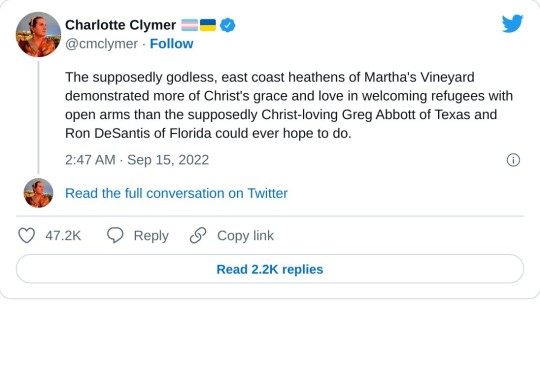
Some of you may have been wondering, "Hey, @dontmeantobepoliticalbut, did DeSantis just use Floridian's taxes to fly migrants in Texas to Massachusetts?"
You'd be half-right. Remember Blue States pay for Red States. Florida used California's reallocated surplus taxes to fly Texas's migrants to Massachusetts...
The $12 million money comes from interest earnings from Florida's $8.8 billion portion of the American Rescue Plan's Coronavirus State Fiscal Recovery Fund. It provided $350 billion to state and local governments, which the U.S. Treasury said is "to support their response to and recovery from the COVID-19 public health emergency."
Another interesting thought....

#us politics#news#business insider#gov. ron desantis#Florida#2022#immigration#immigrants#immigration reform#Texas#Maryland#benny johnson#Sen. Julian Cyr#Rep. Dylan Fernandes#the new york times#fox news digital#Charlotte Clymer#rick wilson#blue states pay for red states#human trafficking#my thoughts#martha's vineyard
471 notes
·
View notes
Text
Texas: I don’t mind homosexuality, as long as it’s my own homosexuality
————————————————————————
California: I feel like Steve Jobs is judging me from his grave
————-————-————-————-————-——
Florida: how do you spell difference?
New York: What 👏 a 👏 genius 👏
————-————-————-————-————-——
Ohio: I'm a skater
Indiana: you smoke weed!?
————-————-————-————-————-——
Florida: how would they know me 🙄💅
————-————-————-————-————-——
Florida: let me gaslight an infant; it’s a harmless crime
————-————-————-————-————-——
South Carolina: I’m an animal in bed
South Carolina: feed me and give me pats
————-————-————-————-————-——
California: these fries are so fucking good
Utah: HeY! In-N-Out Is A chRIStian company-!!
————-————-————-————-————-——
Washington and Oregon: *kiss*
Montana: what are you doing
Idaho: we’re playing gay chicken
————-————-————-————-————-——
*texting*
Florida: *selfie of his forehead*
Florida: Getting ready to go to cort
Gov: you have a beautiful forehead, Florida, but what’s cort?
Louisiana: court*
————-————-————-————-————-——
Florida: I want to eat the scented candle
————-————-————-————-————-——
California: *points to sign that says idfb*
California: I DON'T FUCKING BITCH, FLORIDA. I DON'T FUCKING BITCH 🙄
————-————-————-————-————-——
*texting*
Delaware: PLS
Delaware: SHAKING UR SHOULDERS
Delaware: AGGRESSIVELY
Delaware: TELL ME U GOT THIS
Delaware: PLS
Delaware: BEGGING U
Delaware: ON MY KNEES
Delaware: Fuckkkk
New York: Why does Apple/Samsung not like Delaware😒
Delaware: PLS
Delaware: IM CRYING
————-————-————-————-————-——
Gov: who’s excited Florida’s not here
Everyone: *raises their hands*
Florida: *walks in* what’s up suckers
California: are you okay, gov? You look sad
Gov: I’ve just hit a new level of depression
————-————-————-————-————-——
Washington: why isn’t Oregon Kirby? He loves sucking things
————-————-————-————-————-——
California: tell me who you like, whisper it
Nevada: *whispers*
California: HIM!? WHY HIM!?
————-————-————-————-————-——
Oregon, stuck in his sweater: help, how do I get out of this!?
————-————-————-————-————-——
West Virginia: you cannot tell me $2 can’t pay for college
————-————-————-————-————-——
New York: and then we basically went to y’know what’s it called?
California: bed?
New York: yeah, bed
————-————-————-————-————-——
Utah: I don’t believe in 69
————-————-————-————-————-——
Florida: y’know what’s really underrated? Eating dirt
————-————-————-————-————-——
California: don’t worry, I’ll take her boyfriend so you can have her
————-————-————-————-————-——
Florida: I'm making robbery aesthetic
————-————-————-————-————-——
Alaska (on a call with Hawai’i): FLORIDA KEEPS MAKING BIRD SOUNDS DURING MEETINGS
Hawai’i: are they good bird sounds?
Alaska: THE FUCK?
Alaska: THERE ARE NO GOOD BIRD SOUNDS
————-————-————-————-————-——
Texas: GODLESS HEATHEN!
California: YOU CAN’T CALL ME GODLESS JUST BECAUSE I’M CATHOLIC
————-————-————-————-————-——
New York: western states don’t exist to me, they’re walking fetuses
————-————-————-————-————-——
New York: take my hoodie and I take your ability to walk
Florida: oh~
New York: *grabs bat*
Florida: wait-
————-————-————-————-————-——
Texas: you have no friends!
California: you’ve known Baja for years!
————————————————————————
Kansas: wait… you have farms in California
California: no, the agriculture we produce comes from black magic
————-————-————-————-————-——
Gov: florida, your mommy said you were cute… she lied
————-————-————-————-————-——
Nevada: i like your shoes, they're shiny. Taylor swift could steal them and itd be the coolest thing shes ever done
————-————-————-————-————-——
Gov: california, new york, florida, you’ll be sharing your work in a 3 way
Florida: ooh~
————-————-————-————-————-——
California: you lose your speaking privileges
Virginia: YOU lose your rights *holds up constitution*
California: *grabs it and starts reading it aloud*
————-————-————-————-————-——
Oregon: I got stabbed in my past life! No wonder I don’t want to stab people!
————-————-————-————-————-——
California: Wisdom is a privilege, and we are not privileged people
————-————-————-————-————-——
Florida, on call: SHOW ME WHAT YOU'RE HUNTING
Alaska: do you have any friends?
————-————-————-————-————-——
Alaska: am I sexually active—? No, look at me
————-————-————-————-————-——
California: I have a Tesla for the environment
Texas: you also have a Ferrari
————————————————————————
Florida: *turns on seat heating*
Florida: is my seat hot for some reason
————-————-————-————-————-——
Florida: no one can catch my cold. It’s special
————-————-————-————-————-——
Texas: i’m not homophobic! My boyfriends gay
————————————————————————
Arkansas: *singing in the bathroom in the middle of the night*
Tennessee: *opens door* you come and sing with me, boy
Red: happened irl
Blue: stole from the internet
Black: made it up
#most of govs quotes are from my teacher#wttt#wttsh#wttt texas#wttsh texas#wttt California#wttsh California#wttt florida#wttsh florida#wttt new york#wttsh new york#wttt indiana#wttsh indiana#wttt ohio#wttsh ohio#wttt south carolina#wttsh South Carolina#wttt utah#wttsh utah#wttt washington#wttsh washington#wttt oregon#wttsh Oregon#wttt montana#wttsh montana#wttt idaho#wttsh Idaho#wttt gov#wttsh gov#wttt louisiana
52 notes
·
View notes
Photo
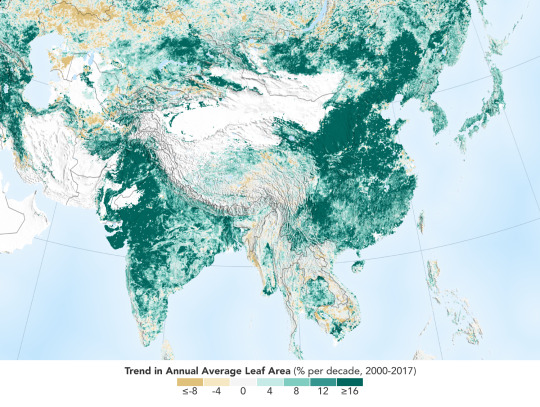
Human Activity in China and India Dominates the Greening of Earth, NASA Study Shows and presented with map.
Over the last two decades, the Earth has seen an increase in foliage around the planet, measured in average leaf area per year on plants and trees. Data from NASA satellites shows that China and India are leading the increase in greening on land. The effect stems mainly from ambitious tree planting programs in China and intensive agriculture in both countries.
The world is literally a greener place than it was 20 years ago, and data from NASA satellites has revealed a counterintuitive source for much of this new foliage: China and India. A new study shows that the two emerging countries with the world’s biggest populations are leading the increase in greening on land. The effect stems mainly from ambitious tree planting programs in China and intensive agriculture in both countries.
The greening phenomenon was first detected using satellite data in the mid-1990s by Ranga Myneni of Boston University and colleagues, but they did not know whether human activity was one of its chief, direct causes. This new insight was made possible by a nearly 20-year-long data record from a NASA instrument orbiting the Earth on two satellites. It’s called the Moderate Resolution Imaging Spectroradiometer, or MODIS, and its high-resolution data provides very accurate information, helping researchers work out details of what’s happening with Earth’s vegetation, down to the level of 500 meters, or about 1,600 feet, on the ground.
Taken all together, the greening of the planet over the last two decades represents an increase in leaf area on plants and trees equivalent to the area covered by all the Amazon rainforests. There are now more than two million square miles of extra green leaf area per year, compared to the early 2000s – a 5% increase.
“China and India account for one-third of the greening, but contain only 9% of the planet’s land area covered in vegetation – a surprising finding, considering the general notion of land degradation in populous countries from overexploitation,” said Chi Chen of the Department of Earth and Environment at Boston University, in Massachusetts, and lead author of the study.
An advantage of the MODIS satellite sensor is the intensive coverage it provides, both in space and time: MODIS has captured as many as four shots of every place on Earth, every day for the last 20 years.
“This long-term data lets us dig deeper,” said Rama Nemani, a research scientist at NASA’s Ames Research Center, in California’s Silicon Valley, and a co-author of the new work. “When the greening of the Earth was first observed, we thought it was due to a warmer, wetter climate and fertilization from the added carbon dioxide in the atmosphere, leading to more leaf growth in northern forests, for instance. Now, with the MODIS data that lets us understand the phenomenon at really small scales, we see that humans are also contributing.”
China’s outsized contribution to the global greening trend comes in large part (42%) from programs to conserve and expand forests. These were developed in an effort to reduce the effects of soil erosion, air pollution and climate change. Another 32% there – and 82% of the greening seen in India – comes from intensive cultivation of food crops.
Land area used to grow crops is comparable in China and India – more than 770,000 square miles – and has not changed much since the early 2000s. Yet these regions have greatly increased both their annual total green leaf area and their food production. This was achieved through multiple cropping practices, where a field is replanted to produce another harvest several times a year. Production of grains, vegetables, fruits and more have increased by about 35-40% since 2000 to feed their large populations.
How the greening trend may change in the future depends on numerous factors, both on a global scale and the local human level. For example, increased food production in India is facilitated by groundwater irrigation. If the groundwater is depleted, this trend may change.
“But, now that we know direct human influence is a key driver of the greening Earth, we need to factor this into our climate models,” Nemani said. “This will help scientists make better predictions about the behavior of different Earth systems, which will help countries make better decisions about how and when to take action.”
The researchers point out that the gain in greenness seen around the world and dominated by India and China does not offset the damage from loss of natural vegetation in tropical regions, such as Brazil and Indonesia. The consequences for sustainability and biodiversity in those ecosystems remain.
Overall, Nemani sees a positive message in the new findings. “Once people realize there’s a problem, they tend to fix it,” he said. “In the 70s and 80s in India and China, the situation around vegetation loss wasn’t good; in the 90s, people realized it; and today things have improved. Humans are incredibly resilient. That’s what we see in the satellite data.”

This research was published online, Feb. 11, 2019, in the journal Nature Sustainability.
133 notes
·
View notes